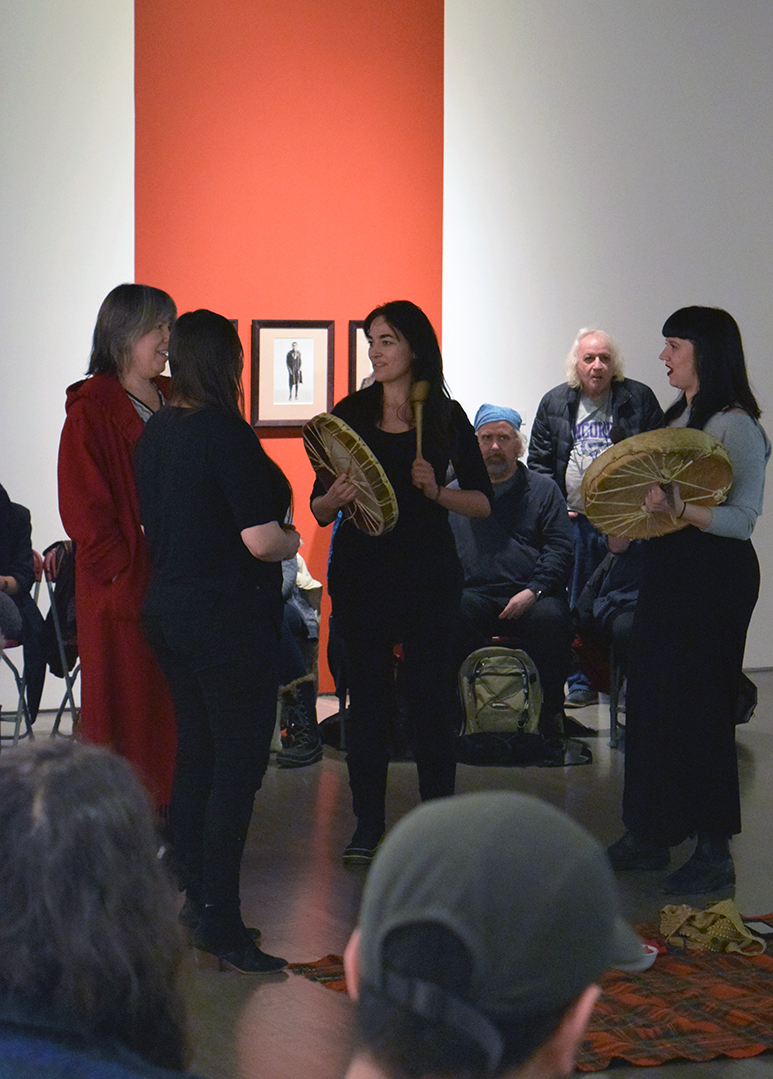
Tuesday, February 28, 5:30 pm
Indigenous women’s drum group, Odaya, responds to the exhibition by way of a concert.
Odaya is a Non-Profit Organization registered in 2007. At that time, most of its founding members were working for Quebec Native Women´s Association in Kahnawake. These dynamic, creative and engaged Aboriginal Women draw their strength from their ancestral heritages. They aim to help raise awareness within the population about the diverse and complex realities of Aboriginal Peoples, as well as the injustices and wounds due to Colonialism. Odaya is also active at creating bridges between Indigenous Peoples worldwide. Its mandate is to create, sing and celebrate the richness of First Nations cultures while creating and supporting projects and events that promote the rights of Indigenous Peoples and women. In the last few years, Odaya was part of many artistic events such as the Accès-Asie Festival, Multi-Montréal Festival, Présence Autochtone Festival and the 400th anniversary of Quebec City. Odaya has also been invited to be part of the International Peoples conference on Arts for Social Transformation (Philippines, 2011) as well as the World Social Forum (Tunisia, 2013).
At the Gallery, free admission

·
Tuesday, February 14, 5:30 pm
Critical commentary by Lindsay Nixon
In a recent text for Canadian Art, critic and curator Richard William Hill asks: “Was Indigenous art better in the 1980s and early ’90s?” Similar ventures into canonizing Indigenous art have led a new generation of artists and visual historians to rejoin: better for whom? The 1980s and 1990s were a dead period for Indigenous queer, trans, and two-spirit art. This is not only an issue of representation, but also an issue of Indigenous governance and a sign of unbalanced relations. Whose identities have we allowed in the gallery and who have we not? Dayna Danger and Adrian Stimson are two of the many Indigenous artists who are creating from their bodies, genders, and sexualities like never before in Indigenous art histories. Danger and Stimson boldly resist the boundaries of what we consider to be Indigenous art, restoring their beings, bodies, genders, sexualities, and reproductive lives from colonial institutions through play, self-representation, and sexual self-determination.
Lindsay Nixon is a nehiyaw-saulteaux-Métis curator, writer, community organizer, and MA student in Concordia University’s art history department. They are the co-founder of the Indigenous Arts Council, and the editor of IAC’s Indigenous literary arts, art, and art criticism journal, mâmawi-âcimowak. They are also the co-founder of the Black Indigenous Harm Alliance. Nixon’s work has appeared in Malahat Review, Room, GUTS, Briarpatch, and other publications. They currently hold the position of Indigenous Editor at Large for Canadian Art magazine. Lindsay currently resides in Tio’tia:ke/Mooniyaang, unceded Haudenosaunee and Anishinabe territories (Montreal, QC).
Lindsay’s research explores the confluence of Cree, Anishinabe, and Métis kinship, identities, and communities in the prairies of colonial Canada and the Northern United States, through art practices that negotiate cultural hybridity. Their work also addresses contemporary issues of relationality, kinship, and love through Indigenous feminist art practices.
At the Gallery, free admission
Videos of the critical commentary by Lindsay Nixon and the Odaya concert are available in the Audio | Video section.
January 21 – April 1st 2017
Curator: Wanda Nanibush
Rebecca Belmore, Lori Blondeau, Dayna Danger, Robert Houle, James Luna, Shelley Niro, Adrian Stimson, Jeff Thomas






